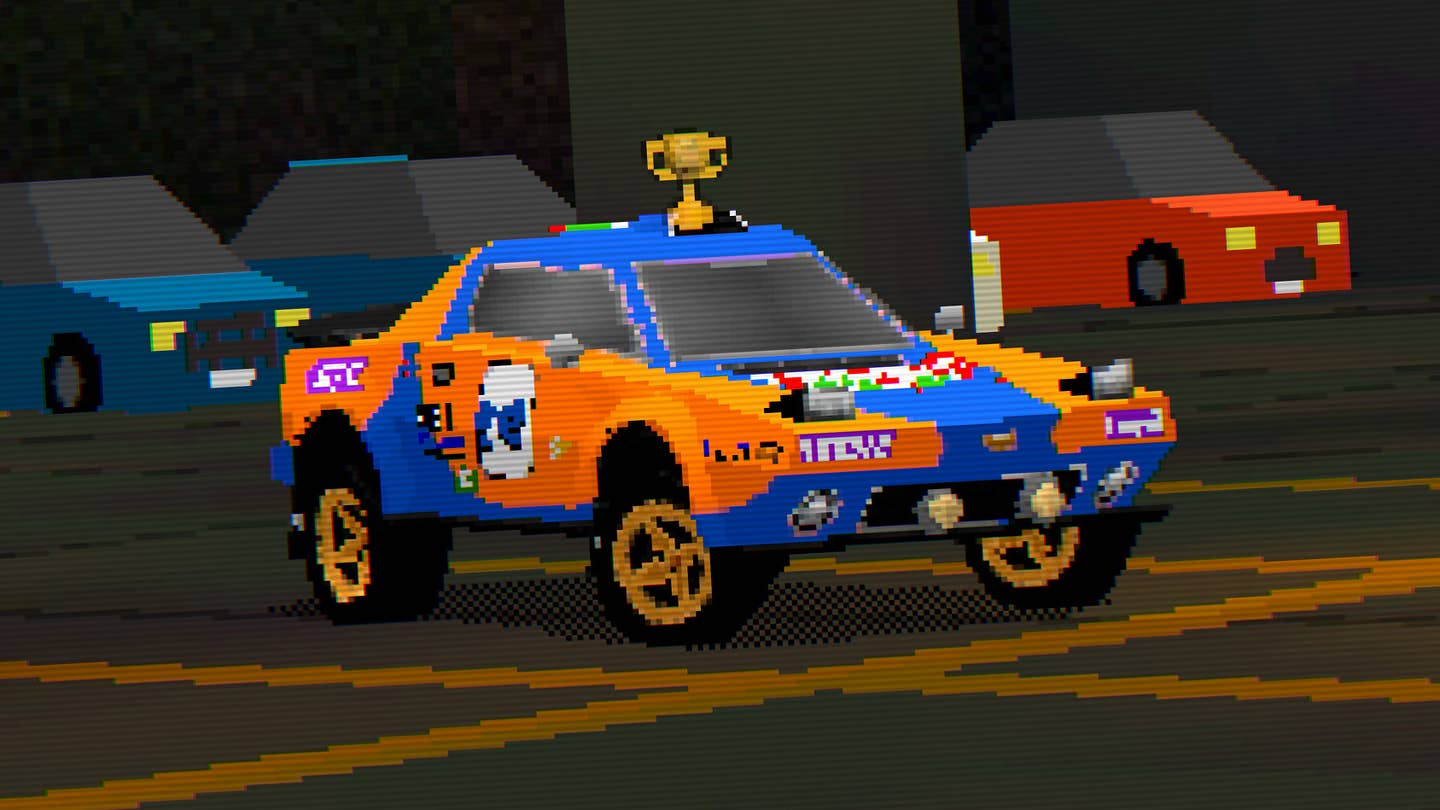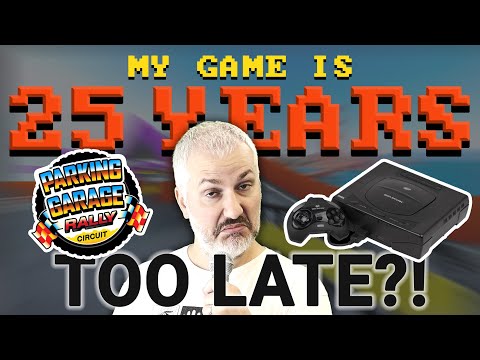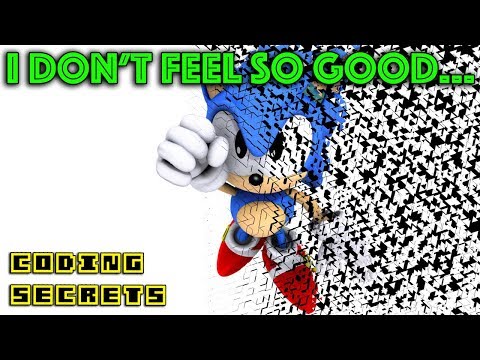This upcoming indie racer goes to amazing lengths to capture the look and feel of Sega’s golden-era racing games.

There’s no shortage of retro-inspired racing games out there nowadays, but “retro” is, of course, a pretty relative term. There are your 2D sprite-scalers like Sega’s Out Run, for example, where graphics all take on the effect of pixelated billboards that get larger and smaller as you move toward them. Or early polygonal stuff like Virtua Racing, where technology progressed to a point where full three-dimensional worlds were possible—but not with textures, so everything looks like origami. Consider that even games like Need for Speed Underground are over 20 years old at this point, and you begin to understand how retro can be an imperfect adjective, by itself.
It’s that distinction that turned me onto Parking Garage Rally Circuit, an upcoming game developed by Tim FitzRandolph as Walaber Entertainment, the mind behind mobile hit Where’s My Water? and indie darling JellyCar. Formerly a game designer and director for Disney and NBCUniversal, FitzRandolph has had a long career making games, but Parking Garage is a totally original love letter to those blue-skied early 3D racers, specifically on Sega’s ill-conceived Saturn console.

The premise is simple: You drive a rally car and aim to achieve the fastest time through a course that winds through a parking garage. The track is narrow, the controls are responsive, and the graphics are blocky in a very specific way we’ll get into, that’s special to the Saturn. It’s just you, a multi-story circuit, a drift button, and the ghost cars you’re chasing down that represent the times to beat. At present there are four tracks and three cars, the latter separated by speed and weight class. There you go.
For some, that might be a little too barebones. But for those of us who grew up with a trio of selectable courses and maybe a choice of automatic or manual transmission if we were lucky, PGRC scratches the right itch. The joy isn’t in the quantity of content, but the satisfying, easy-to-learn, hard-to-master physics and improving your time, run after run.
“Parking Garage Rally actually came about cause of a game jam,” an event where developers try to create games from scratch, typically in a short amount of time, FitzRandolph told me over the phone. “There’s always some theme that you have to incorporate into your idea, and the most recent one’s theme was ‘limited space.'” FitzRandolph got thinking about the kind of game that would normally cover a large area that might be interesting in a more confined space, and he settled on a racing game.
The Seattle track, with its spiral ramps, offers plenty of potential for lengthy drifts. The Drive, Walaber Entertainment
The first version of PGRC was built in 72 hours, for the game jam. “The choice to make it kind of retro style was sort of just of a natural one,” FitzRandolph said. “[It’s] the type of concept to me that seems like it would’ve been like a first-gen 3D console, 1990s-kinda idea. Not to mention, [retro] is a style where you don’t need all these super-detailed 3D models and textures and stuff. With a small team, as a solo person, I can make it look good as well as have that vibe.”
To FitzRandolph, the association with Sega’s vibrant, typically goofy arcade racers of the ’90s, like Daytona USA and Sega Rally Championship, was immediately clear. He could’ve simply borrowed their saturated color palettes, but if you’ve ever played anything on a Saturn, you’ll immediately notice that PGRC goes much further to abide by the limitations of 30-year-old hardware doing rudimentary 3D.
Graphics on “Saturn [were] fundamentally based on rectangles,” FitzRandolph said. “So basically, the PlayStation is triangles, everything’s a triangle, which is more like modern games. But the Saturn was ‘everything’s a sprite,’ which is a rectangle, and then you just happened to transform it like it was in 3D.” The embedded video below by the director and lead programmer of Sonic R, a 1997 racing game developed by Traveller’s Tales for Saturn, explains the difference in Sega’s approach to Sony’s, as well as one of the most notorious headaches it caused developers.

“It’s not super evident in my game, but I’ve built the levels out of little tiles,” FitzRandolph said. “Basically all the tracks are made out of these little square pieces, and my system can show and hide those squares individually.” That, in turn, helps emulate the way parts of objects—say, a building, or a mountain, like in the above video—tended to pop into view in chunks in Saturn games, rather than entire objects all at once. Additionally, FitzRandolph relies on a classic dithered approach—literally checkerboarding pixels—to create translucent effects like shadows, tire tracks, and smoke, because that’s what most developers did on Saturn.
The result looks phenomenal. I’m a stickler for this stuff, and there’s a certain digital signature to the way Saturn games are presented that definitely comes through in PGRC, an attention to detail that you don’t often see from ostensibly retro-minded games. And for those players that couldn’t bear to behold a “potato” experience on their superpowered PCs, many of those effects intended to evoke déjà vu, like the super-short draw distance, low framerate, and tube-TV scanline filter can be turned off for smoother, more modern gameplay. The cohesive design enhances what already, in this pre-release alpha state, feels like a really sharp and lighthearted old-school arcade racer.
FitzRandolph was nice enough to provide me with a test build of PGRC, and I’m really enjoying what I’ve played so far. At the moment all it needs is music, which will be in the final version. I liken it to Trackmania, Ubisoft’s competitive, time trial-focused racing game that enjoys a super-dedicated cult following, except PGRC isn’t as fast and twitchy, nor anywhere near as miserable to play if you don’t have esports-caliber talent. The handling is predictable in spite of the cars’ comically exaggerated suspension travel, and incorporates a drift-to-boost mechanic FitzRandolph likens to Mario Kart’s. There are four tracks at the moment, and their designs are tight and technical, but not claustrophobically so.
“After the game jam version, I went to start making the real version, and I realized I needed to widen things up a little bit,” FitzRandolph said. “The game jam version, things were realistic-sized for a parking garage. And now in the game, it’s like you took a parking garage and you kind of scaled it up just a little bit, so everything is a little bit wider than it would be in reality, but that makes it a little more forgiving and enjoyable.”
The tracks are strewn with tons of obstacles, like curbs, barriers, parked cars and, in the case of the Mt. Rushmore locale, rolling boulders to dodge, but striking most of the smaller ones won’t force you to a dead stop and kill your run. So it’s got the old-school vibe and handling, but some of those less desirable aspects of classic arcade racers, like infuriating collision detection, thankfully aren’t here. There will also be a multiplayer mode where you can race against real-time ghosts representing other players’ cars because physically racing wheel-to-wheel on these courses probably wouldn’t be a good time.
It’s all shaping up to be a thoughtfully crafted tribute to racing games of old, even though FitzRandolph doesn’t consider himself much of an automotive enthusiast beyond being into remote-controlled cars when he was younger. “Cars tend to show up a lot in the games [I’ve made], I don’t really know why!” he laughed.
“I have a lot of memories of car games that were kind of formative, I guess,” FitzRandolph continued. “Cars are really just dynamic and fun. They’re kind of like the second option besides a character that are really interesting, the way they move, people understand it … they’re a fun thing to control.”
Indeed, you should have some fun whipping them around Parking Garage Rally Circuit’s concrete towers when the game releases around the fall of this year.
Wanna talk racing games? Hit me up at adam.ismail@thedrive.com


